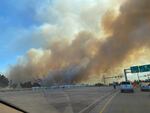At around 11 a.m. on Sept. 8, Mary Martin was standing outside her home at Royal Oaks Mobile Manor talking with her neighbor about a branch that had fallen on his awning.
“Then another neighbor came out and he was showing him,” Martin said. “And then the planes flew over with the fire retardant. And that’s what we noticed first.”

Medford resident Mary Martin lost her home and cat during the Almeda Fire. She was told to evacuate by a police officer before the fire destroyed the mobile home park where she lived.
Erik Neumann / JPR
Martin has lived in the Rogue Valley for seven years. She’s on a fixed income and lives by herself, except for her cat, Cambria.
After seeing the planes she looked for information on TV but couldn’t find any. Outside, she started to see smoke. That’s when a police officer arrived and said ‘get out now.’ She had five minutes, she said. She couldn’t even get her cat out from under the bed.
Martin got two neighbors in a car, one who was disabled and the other who couldn’t see well, and they left.
“As soon as we turned out and I looked in the rear-view mirror I saw the black smoke,” she said. “It did look like a monster coming.”

Smoke from nearby wildfires fills the sky are Jefferson Public Radio reporter April Ehrlich drives for the Interstate 5 on-ramp in Phoenix, Ore., on Tuesday, Sept. 8, 2020. Thousands of Oregonians have been forced to flee their homes as wildfires kicked up by dry, windy conditions swell across the state.
April Ehrlich
Within hours, the fire swept through Royal Oaks Mobile Manor. Martin lost her mobile home and everything in it, including her cat. Nearly two weeks after the fire, she said, she’s still in shock.
Officials estimate that more than 2,300 homes were destroyed in the Almeda Fire, mostly in Talent and Phoenix. Amazingly, through the efforts of law enforcement and emergency responders, only three people are known to have died. It could have been much worse.
The fire was unprecedented in the Rogue Valley, fueled by drought conditions and high winds. But during the fire, neither of Jackson County’s emergency notification systems worked as intended.
Related: We know climate change set the conditions for Oregon fires. Did it stoke the flames, too?
Jackson County can send out two types of emergency alerts. One is through the Integrated Public Alert and Warning System, better known as IPAWS. It’s FEMA’s national emergency system.
“It has to be an eminent, unanticipated event that is going to cause severe destruction or death. So, there are pretty specific criteria to launch an IPAWS type message,” said Stacey Anderson-Belt, the emergency manager with Jackson County. JPR spoke with Belt in mid-August about the FEMA IPAWS alert system.
“That’s going to be the ticker-tape on the bottom of the television, that’s going to be going out to AM/FM radio, satellite radio, all broadcast stations,” Belt said. “It’s also, if I select the wireless emergency alert, and you are designating a geographic area, it is going to ping every cell phone in that area regardless if they’ve signed up to receive alerts.”
During the Almeda Fire, Jackson County did not send out an IPAWS alert. So, residents like Martin didn’t get an evacuation message.
“I didn’t have internet, I didn’t have cable TV, so I didn’t have that news,” Martin said. “I didn’t see a ticker on the bottom of the TV or anything.”
The second notification system the county uses is sent through a software program called Everbridge. Residents sign up in advance to get alerts. But there were problems with Everbridge too.
Jennifer Walker lives in Phoenix. She’s been in the area since 1965. Her late husband worked in law enforcement in the Rogue Valley for 38 years and her father was the head of the local weather service for 20 years. When the forecast for strong winds came up before the fire, she could tell conditions were bad.
“We have had how many days [of] 100-degree temperature? We have single-digit humidity?” Walker said, recalling the days before the fire. “This is a recipe for freaking disaster.”

Phoenix resident Jennifer Walker was signed up for local emergency notifications but received none during the Almeda Fire.
Erik Neumann / JPR
Walker had previously signed up for Jackson County’s alerts but hadn’t checked her account in years. Then the fire started.
“There wasn’t anything readily available for me to call and I wasn’t getting any alerts. And when I had the chance to go and sign in, I couldn’t even use my password,” she said.
Outside, she saw the smoke plume and DC-10 air tankers dropping fire retardant. A Phoenix police officer drove down the road and told her ‘you need to go now.’ So, she left. The fire stopped about a quarter-mile from her house.
This combination of federal and local alerts is how all counties in Oregon and California operate. In Oregon, some don’t even have a system like Everbridge.
In Lake County, they had just bought an emergency notification program called AlertSense in late August.
“Our office just recently purchased a mass-notification system,” said Lake County Sheriff Deputy Daniel Tague. “We’ve been pushing for it for a long time and we’ve been setting it up as we speak.”
Counties must register to use the federal IPAWS system. But testing those alerts doesn’t always happen.
Related: How you can help neighbors, communities during this historic wildfire season
Kymmie Scott is the emergency services manager for Del Norte County in California. They got access to IPAWS this year. JPR spoke to her before the recent fires when the major health concern was the coronavirus pandemic. She said they’ve been hesitant to test it when the public is already on edge.
“People are already overwhelmed with the amount of emergency management information they’re receiving because of the current incident,” Scott said. “Typically when there’s something in real life going on we don’t do testing.”
Jackson County is a registered IPAWS user. But, according to records provided by FEMA and an agency spokesperson, their log data shows the county has never tested the wireless emergency alerts live or for practice in FEMA’s lab testing environment.
“Of the counties on the list that are IPAWS users, the IPAWS log data does not show any alerts – live via IPAWS WEA [Wireless Emergency Alerts] or practice in the IPAWS Lab environment – coming from the following counties: CA: Del Norte, Tehama, OR: Jackson, Klamath. These counties may have agreements in place with a neighboring county or state level agency to send alerts to people in the counties jurisdiction when needed,” a FEMA spokesperson wrote in an email to JPR.
Officials in Jackson County did not respond to requests for comment for this story.
Jackson County Sheriff Nate Sickler said last week that if an alert had been sent, the situation could have been worse if everyone tried to leave at once, snarling traffic.
“If those roads would have blocked any more, we can’t say what could have occurred, but it could have been tragic,” Sickler said. “We had a hard enough time clearing the roads to get people out as it was.”
Phoenix resident Jennifer Walker said she thinks better communication didn’t happen because resources were spread out too fast, in a type of fire no one had experienced before in the Rogue Valley.
“I have no concerns about whether or not they tried their best, I just don’t think what’s there is best enough,” Walker said.
According to meteorologists at the National Weather Service office in Medford, the wind event that fanned the Almeda Fire was unique for September, but not unprecedented. They’re more common later in the season, around October after there’s usually been rain.
Medford resident Mary Martin said despite losing her home, her cat and everything she owns, she’s not planning to leave the Rogue Valley.
“I have a family here,” Martin said. “It’s my family of choice.”
For now, she’s staying with a friend. And, like many, she’s trying to raise money with a GoFundMe campaign.
The Almeda Fire is now contained. At this point it’s unclear why a mass notification was not sent out or if something went wrong. Last week officials said they needed time to do a thorough debrief of what happened during the fire.